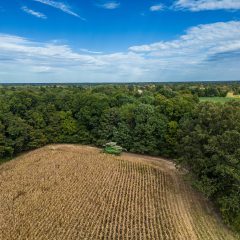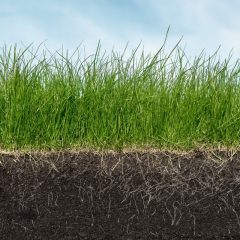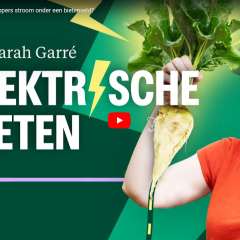Dossier Desealing
Today, vacant agricultural sites are often transformed into residential farms or non-agricultural enterprises. If we don't stop this dynamic, farms will no longer be available for agricultural use and our countryside will disappear along with them. Smart desealing can be part of the solution.
What does ILVO do?
-
 Systems analysis shows relationships between the factors affecting desealing of agricultural sites and which factors promote desealing.
Systems analysis shows relationships between the factors affecting desealing of agricultural sites and which factors promote desealing. -
 Through data integration and mapping analysis, desealing potential of likely vacant agricultural sites is identified.
Through data integration and mapping analysis, desealing potential of likely vacant agricultural sites is identified. -
 Scenarios of value creation are visualized and calculated using the mapping of desealing potential.
Scenarios of value creation are visualized and calculated using the mapping of desealing potential.
Desealing, a necessity for improving our living environment
Flanders is one of the most paved areas in Europe. Today 16% of the surface is paved and if we continue like this it will be more than 20% in 2050. Paved space is space that is occupied by buildings, roads, parking lots, terraces and driveways, for example, which disrupt some of the natural functions of non-paved space. Indeed, soil and open space perform many functions that maintain ecological balance. When a paved area seals the soil, all those functions are lost. This results in, among other things, a greater risk of flooding, less water infiltration, warmer cities and towns, less CO2 storage by plants and the soil, and a loss of biodiversity.
Desealing provides more space for nature and food production, less flooding, cooler cities, greater biodiversity, healthier air and a better climate. In this way, we are focusing on climate adaptation and climate mitigation, and we are taking a step towards a more climate-proof and liveable Flanders. Desealing tackles many challenges at the same time, which makes it unusual.
That's why Flanders is breaking out! "Vlaanderen breekt uit"!
To take a first step towards accomplishing desealing in Flanders, the Flemish Government launched a call for projects, 'Ontharding Pilot Projects', in which 45 pilot projects were selected, which the Flemish Government designates as their "pilot projects" or "proeftuinen" in Dutch.
Through these pilot projects, the Flemish Government wants to stimulate and support concrete softening initiatives, and thus further research to better grasp the complexity of the task. In addition to 41 quick-wins, whereby specific and practical desealing initiatives are achieved, resources were also freed up for 4 systemic softening projects. These systemic "pilots", which in concrete terms mean that a broader, systemic thinking exercise is taking place, all aim to gain more insight into the complex relationship between geographical, policy, legal, financial, emotional, etc. factors that have an impact on desealing decisions, and to identify leads for further realization. Thus, structures can eventually be released through these systemic pilots as well. One of these four thinking projects is the project "Boer ruimt veld", in which ILVO reflects on the possibilities of desealing agricultural properties.
Non-agricultural re-use of farms leads to urbanization and paving of the countryside
The link between vacant farms and the further urbanization of the countryside has been substantiated by numerous ILVO studies. Dynamics such as urbanization, land abandonment, residentialization and increasing non-agricultural activity in the countryside start from the reuse of farms that have lost their agricultural function. Not only the buildings are given a non-agricultural use, but also the surrounding land is often converted into gardens and pastures for hobby animals.
It is striking that within this current reuse dynamic, desealing is hardly ever accompanied by conversion into new open agricultural space. From a financial perspective, this makes sense. The legal provisions (or rather the lack of them), which allow a function change of agricultural buildings without much difficulty, ensure that non-agricultural reuse (and thus perpetuation) of these paved areas becomes much more attractive than desealing. After all, desealing costs money, and the real estate value of a vacant farmstead is simply much higher than the agricultural value and recouping potential of desealed, and thus uncultivated, agricultural land.
In addition, a farmer today still has the possibility to establish a completely new farm on a previously uncultivated plot, an option that is cheaper and therefore more interesting than the purchase and reuse of a vacant farm. Thus, additional hardening of agricultural space still comes from this angle as well.
The (non-agricultural) reuse of vacant farmsteads thus leads to increased competition for both agricultural buildings and land. An improved policy with regard to vacant farms could therefore be the key to steering the transformation of the countryside.
Desealing creates more space for food production
Via research, ILVO wishes to contribute to the roll-out of the strategic vision of the Flanders Spatial Policy Plan, more specifically to objective 5 "Robust open space" whereby the Flemish Government aspires to:
- reduce the degree of hardening in agriculture, nature and forest by at least one-fifth by 2050
- the ambition by 2050 to reduce the proportion of agricultural land not used by professional agriculture to under 2015 levels, and
- to consider the reuse of former farm buildings or other existing non-zoned buildings and developments in open space.
ILVO is therefore actively supporting this Flemish desealing ambition, and is further investigating how desealing can safeguard and create space for food production. This is done within the research project 'Boer ruimt veld', a project that responds to the need for a well thought-out and broadly supported softening policy with the ambition of preserving and strengthening open agricultural space.
Within that initiative, ILVO coordinates the systemic pilot projects for desealing 'Boer ruimt veld'. Within the consortium ILVO - Boerenbond - Voorland - KULeuven the possibilities, obstacles and needs for desealing are examined and workable recipes for desealing agricultural areas are identified. Specifically, the desealing potential at abandoned farms and the challenges of repurposing them into agricultural land are mapped: from a sealed farm to a productive farm. The desealing of vacant agricultural sites envisaged in these pilot projects is not an end in itself, but a means to counter unwanted transformations and make land available again for professional agriculture and horticulture. The vacant (hardened) farm thus becomes a productive farm.
Farmer clears field - but which field?
Based on data integration and mapping analysis, the desealing potential of presumably vacant agricultural sites is quantified. The analysis consists of four consecutive sub-questions:
- identifying the presumed vacant sites from the logic of abandonmen
- identifying the sealed areas and the space taken;
- identifying the desealing potential of presumptively abandoned agricultural sites with no reuse value to agriculture or society; and
- identifying linkage opportunities to leverage realization.Based on data integration and mapping analysis, the desealing potential of presumably vacant agricultural sites is quantified.
Linkage opportunities
Desealing abandoned agricultural sites can create a significant added value to the open space challenges. ILVO baptized this added value as the "area-specific linking opportunity for softening" and is therefore looking for linking opportunities between desealing agricultural sites that are presumably being taken out and area-specific tasks. The linking opportunities can be divided into opportunities through benefits and opportunities through avoided costs. The latter category includes the social costs avoided by breaking up fragmented agricultural sites. No prioritization is made here, but cartography is used to visualize various scenarios of area-differentiated forms of value creation (nature, climate, etc.) and to calculate choices.
Farmer clears field (Boer ruimt veld): lessons from practice
To link lessons from practice to the desktop research and to gain a better understanding of the attitude of the agricultural sector toward the softening potential of vacant agricultural sites, Boer Ruimt Veld is engaging in conversations with farmers and policy. From those conversations, barriers and opportunities are identified. For four pilot cases, a theoretical plan of action for softening is developed on the basis of in-depth research to further investigate constructional, socio-cultural, financial-legal and spatial factors.
Culture shift about desealing
The findings are tested in various consultations and workshops with farmers, experts and policy makers. This will allow a supported approach to spatial softening to be developed within the agricultural sector. In this way, softening will hopefully gain strategic importance in a broad future vision for agriculture.











